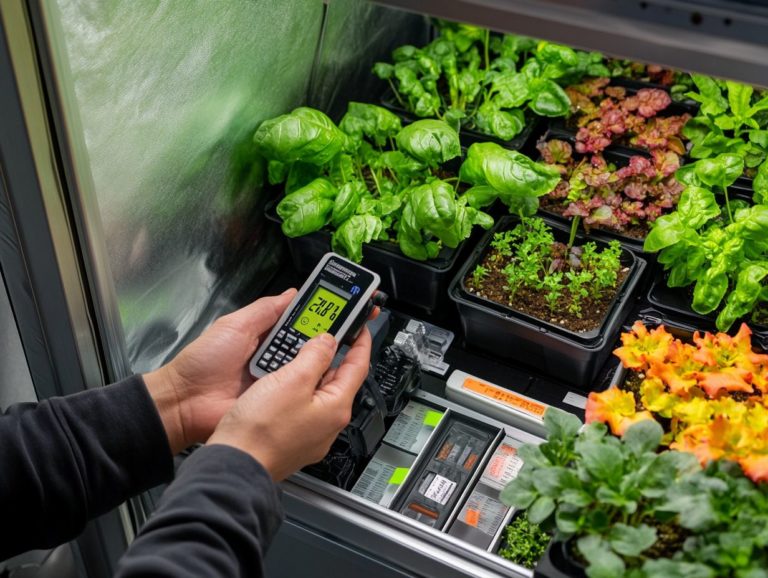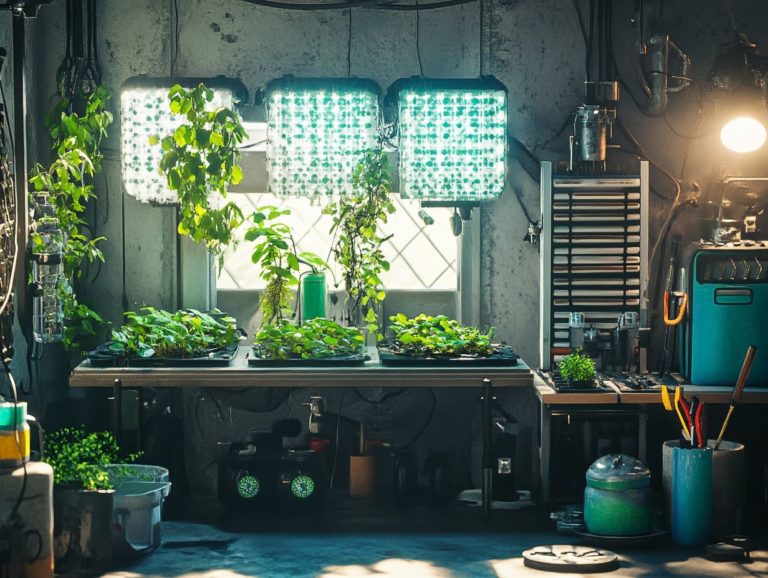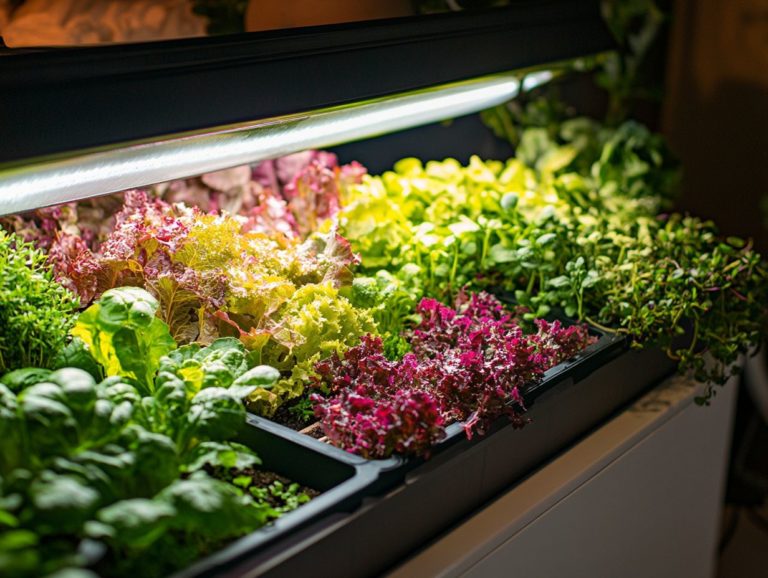How to Start DIY Hydroponic Gardening Today
Hydroponic gardening is changing the way you grow plants. It offers a soil-less method that optimizes space and efficiency.
This article explores the essence of hydroponic gardening. It highlights its many benefits and the various systems available to meet your needs.
You ll find a list of essential supplies and a comprehensive step-by-step guide to set up your hydroponic garden. You’ll also find valuable tips on choosing the best plants and keeping your garden thriving.
Start your DIY hydroponics today! Save money and help the environment while you grow your own plants!
Contents
- Key Takeaways:
- What is Hydroponic Gardening?
- Types of Hydroponic Systems
- Supplies and Materials Needed
- Setting Up Your Hydroponic Garden
- Choosing and Growing Plants
- Maintenance and Troubleshooting
- Benefits of DIY Hydroponic Gardening
- Frequently Asked Questions
- 1. How do I start DIY hydroponic gardening today?
- 2. Can I use any container for DIY hydroponic gardening?
- 3. How do I choose the right growing medium for my hydroponic system?
- 4. What type of nutrient solution should I use for my hydroponic garden?
- 5. Is DIY hydroponic gardening suitable for beginners?
- 6. Can I grow any type of plant using hydroponic gardening?
Key Takeaways:

- Start your DIY hydroponic garden today and enjoy the benefits of this efficient and sustainable gardening method.
- With various hydroponic systems to choose from and a step-by-step guide, setting up your garden can be easy and customizable.
- Save money and reduce your environmental impact by growing your own plants with essential supplies and materials for hydroponic gardening.
What is Hydroponic Gardening?
Hydroponic gardening offers a new way to grow plants without soil. This method allows for efficient growth through a nutrient solution that delivers essential nutrients directly to the roots.
By using a hydroponic system, you can improve growing conditions. This technique is especially appealing for indoor gardening enthusiasts. Imagine growing a wide variety of plants from vibrant tomatoes to crisp leafy greens like lettuce and spinach.
Hydroponic gardening provides a sustainable solution and maximizes space. It’s an excellent choice for urban dwellers who want to green their living environments.
Explanation and Benefits
Hydroponics comes with many benefits that make it a great option for both new and experienced gardeners. It enhances gardening efficiency while allowing you to maintain a precise nutrient balance, leading to optimal plant growth.
This gardening method not only conserves water using up to 90% less than traditional practices but also reduces pest occurrences. This results in healthier plants. With a controlled environment, you can enjoy faster growth rates and reap the rewards of your labor sooner.
Plus, hydroponic systems are energy-efficient, producing high yields while requiring fewer resources. Whether you re growing a small home garden or scaling up for larger operations, hydroponics is a sustainable choice for anyone who wants to grow food.
Types of Hydroponic Systems
You ll find various hydroponic systems, each offering a unique approach to growing plants. From vertical designs that save space to systems using a water reservoir for steady nutrient delivery to the roots, the options are diverse and innovative.
Comparison and Choosing the Right System
When choosing a hydroponic system, consider the different types based on factors like how beginner-friendly they are, their space requirements, and the specific plants you want to grow. This careful consideration will help you make informed decisions for your hydroponic garden.
For instance, systems like the Kratky method or deep water culture are popular for beginners due to their simplicity and low maintenance. These setups typically require minimal equipment and fit well in small spaces, making them ideal for apartment gardens.
If you re feeling adventurous, more advanced options like aeroponics (growing plants in air with a nutrient mist) and nutrient film technique can deliver quicker results and accommodate a wider variety of crops.
Don’t forget to consider your budget. Some systems can be created from budget-friendly materials, while others may require a larger initial investment. By assessing these factors, you can find a system that aligns with your gardening goals and lifestyle.
Supplies and Materials Needed
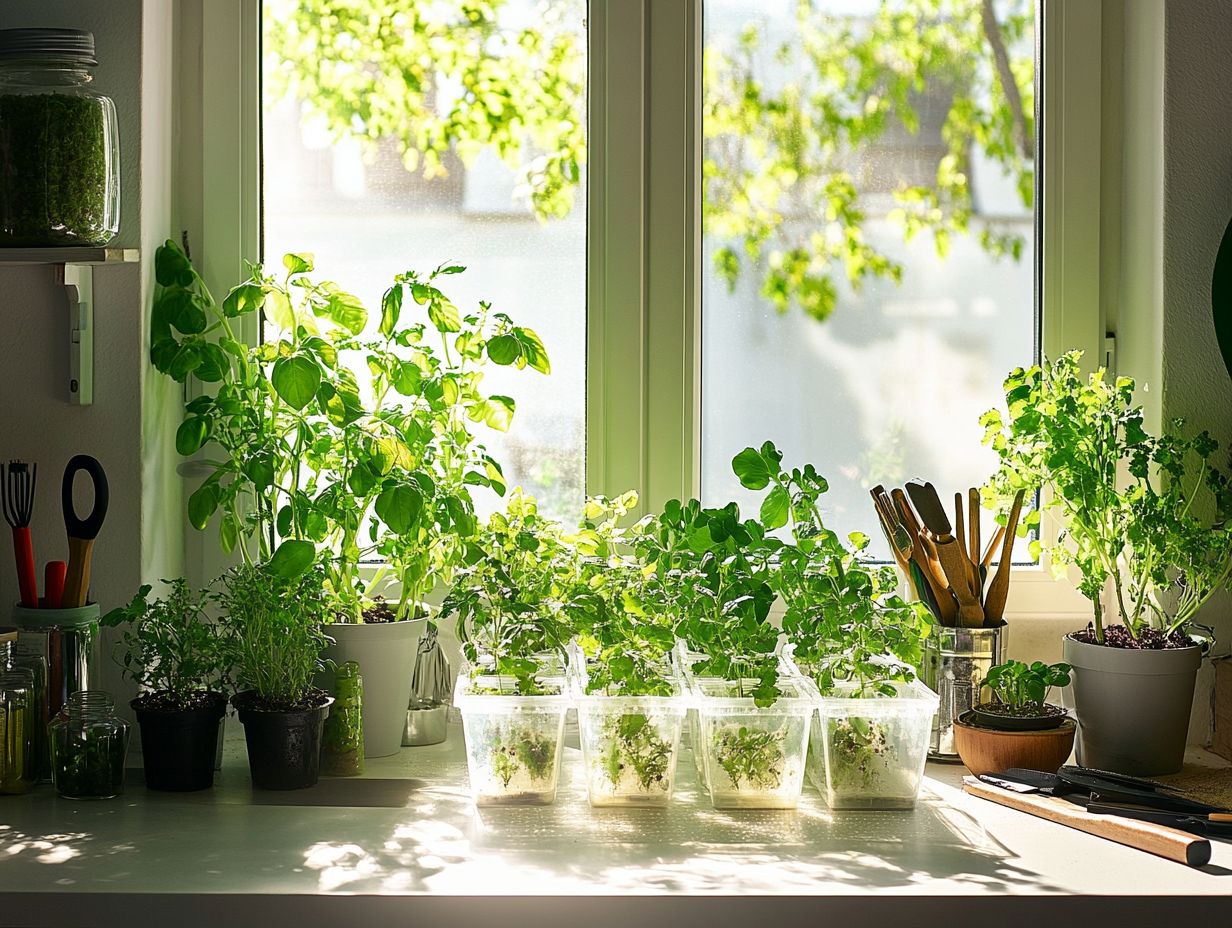
To establish a thriving hydroponic garden, you ll require a selection of high-quality supplies and materials. This includes fundamental items such as PVC pipe for constructing your system, a reliable water pump to ensure optimal nutrient circulation, and premium plant nutrients to foster robust growth.
Essential Tools and Equipment
Essential tools and equipment for your hydroponic gardening journey include an electric timer to seamlessly automate your lighting and watering schedules, and a pH meter to maintain optimal water quality.
A water pump is essential for circulating nutrient-rich solutions throughout your system. This ensures even distribution to your plants’ root zones.
An air pump is also vital. It boosts oxygen levels in the water, promoting healthier roots and better nutrient absorption.
Employing grow lights can effectively simulate sunlight for your indoor plants, helping to regulate their growth cycles. Each of these components plays a crucial role in achieving high yields and fostering vibrant plant health. Investing in reliable tools is essential for maintaining optimal water levels and ensuring effective nutrient retention.
Setting Up Your Hydroponic Garden
Get ready for a rewarding adventure in gardening! Establishing your hydroponic garden is not just a task; it’s a gratifying journey. By following a step-by-step guide, you can streamline the setup process, ensuring that you cultivate an efficient system for growing plants indoors with ease and success.
Step-by-Step Guide
Begin your hydroponic journey by choosing an ideal location that boasts ample light and access to a water reservoir. Next, prepare your nutrient solution, tailored specifically to the plants you plan to cultivate.
Once you’ve pinpointed the perfect spot, ensure it remains easily accessible for maintenance and monitoring. Then, set up your hydroponic system based on the scale of your project, whether it’s a straightforward container or an intricate vertical system. For more information, check out the hydroponic systems for home gardeners. Pay careful attention to the water reservoir; it should be securely positioned for optimal drainage.
Following that, mix your nutrient solution with precision, adhering to the exact measurements outlined in your planting guides. When everything is in place, it’s time to sow your seeds or transfer seedlings into your chosen medium, ensuring they thrive in this innovative growing environment. If you’re interested in learning more about setting up your garden, check out this guide on how to start a hydroponic herb garden.
Choosing and Growing Plants
Selecting the right hydroponic plants is crucial for cultivating a flourishing garden. By understanding which varieties excel in hydroponic systems, you set the stage for a successful indoor oasis, perfect for producing the fresh ingredients that will elevate your salad game for years to come.
Best Plants for Hydroponic Gardening
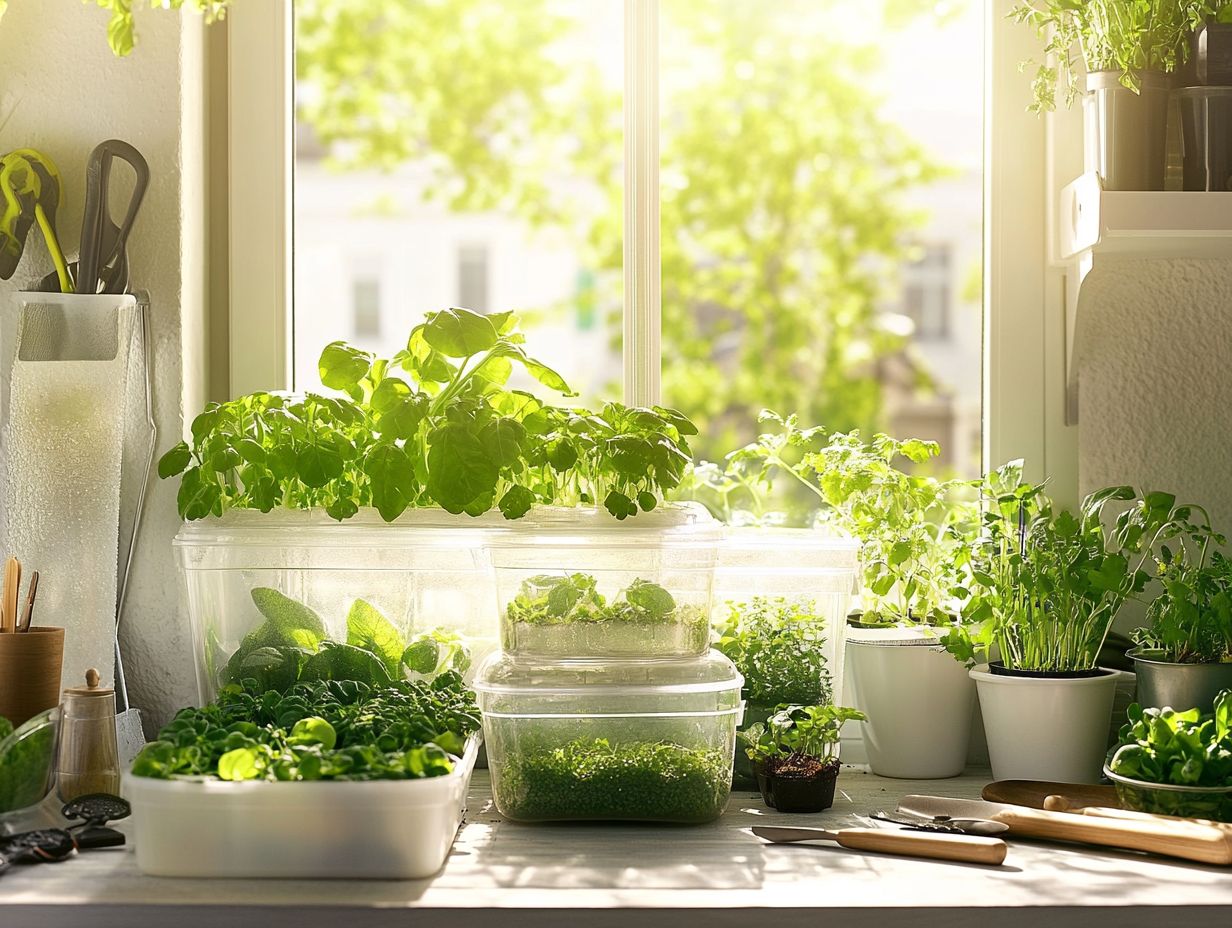
Some of the finest plants for hydroponic gardening include nutrient-rich varieties such as tomatoes, strawberries, lettuce, and spinach. These not only thrive in a hydroponic system but also elevate your meals with their delicious and healthy offerings.
These plants flourish in a carefully controlled environment where you can expertly manage light, nutrient levels, and water. For example, tomatoes revel in consistent warmth and a potassium-rich nutrient solution, ensuring bountiful fruit production. Leafy greens like lettuce and spinach favor cooler temperatures and shorter days, making them perfect for indoor setups.
Your choice of hydroponic system can also make a significant difference. The Nutrient Film Technique (NFT) is particularly effective for strawberries, as it allows a thin film of nutrient solution to flow over the roots, giving them plenty of oxygen. By selecting the right varieties and optimal conditions, you can savor a diverse harvest year-round.
Maintenance and Troubleshooting
Regular maintenance is essential for cultivating a thriving hydroponic garden. By mastering troubleshooting techniques, you can swiftly identify and address common issues, ensuring that you maintain the optimal nutrient balance and foster healthy growth.
Tips for Keeping Your Garden Healthy
To maintain a thriving hydroponic garden, regularly check your nutrient solution, water levels, and pH levels. These elements are crucial for plant growth and overall health.
By monitoring these factors consistently, you can ensure your plants receive the optimal balance of nutrients they need for robust development. Keeping an eye on environmental conditions like humidity, temperature, and light exposure will further enhance your plants vitality.
If you notice signs of stress, such as yellowing leaves or stunted growth, investigate immediately. These issues could stem from nutrient deficiencies or improper environmental settings. Keeping a daily or weekly log helps you recognize patterns and make necessary adjustments, ultimately leading to a flourishing hydroponic ecosystem.
Benefits of DIY Hydroponic Gardening
Imagine growing your own fresh veggies at home! Engaging in DIY hydroponic gardening isn’t just a fulfilling hobby; it also offers substantial cost savings and positively impacts the environment.
By cultivating fresh produce at home, you enhance your culinary experience and take a significant step toward reducing your carbon footprint. It’s a win-win that elevates both your lifestyle and your commitment to sustainability.
Cost Savings and Environmental Impact
The cost savings with hydroponic gardening are impressive, especially when you consider the reduced need for store-bought produce. This approach keeps expenses down while contributing positively to the environment through sustainable urban gardening practices.
Hydroponic systems can yield up to 30% more produce compared to traditional farming methods, presenting a significant advantage for both home growers and commercial operations. For those interested in this method, learning how to use hydroponics for indoor gardening is crucial. These systems often use about 90% less water, making hydroponic gardening highly efficient.
Moreover, hydroponic gardens can be set up right in urban areas, minimizing transportation costs and ensuring access to fresher produce while lowering carbon footprints. As more individuals embrace this innovative approach, the potential for cost savings and environmental benefits continues to grow, making it an attractive option for budget-conscious consumers and eco-friendly advocates.
Frequently Asked Questions
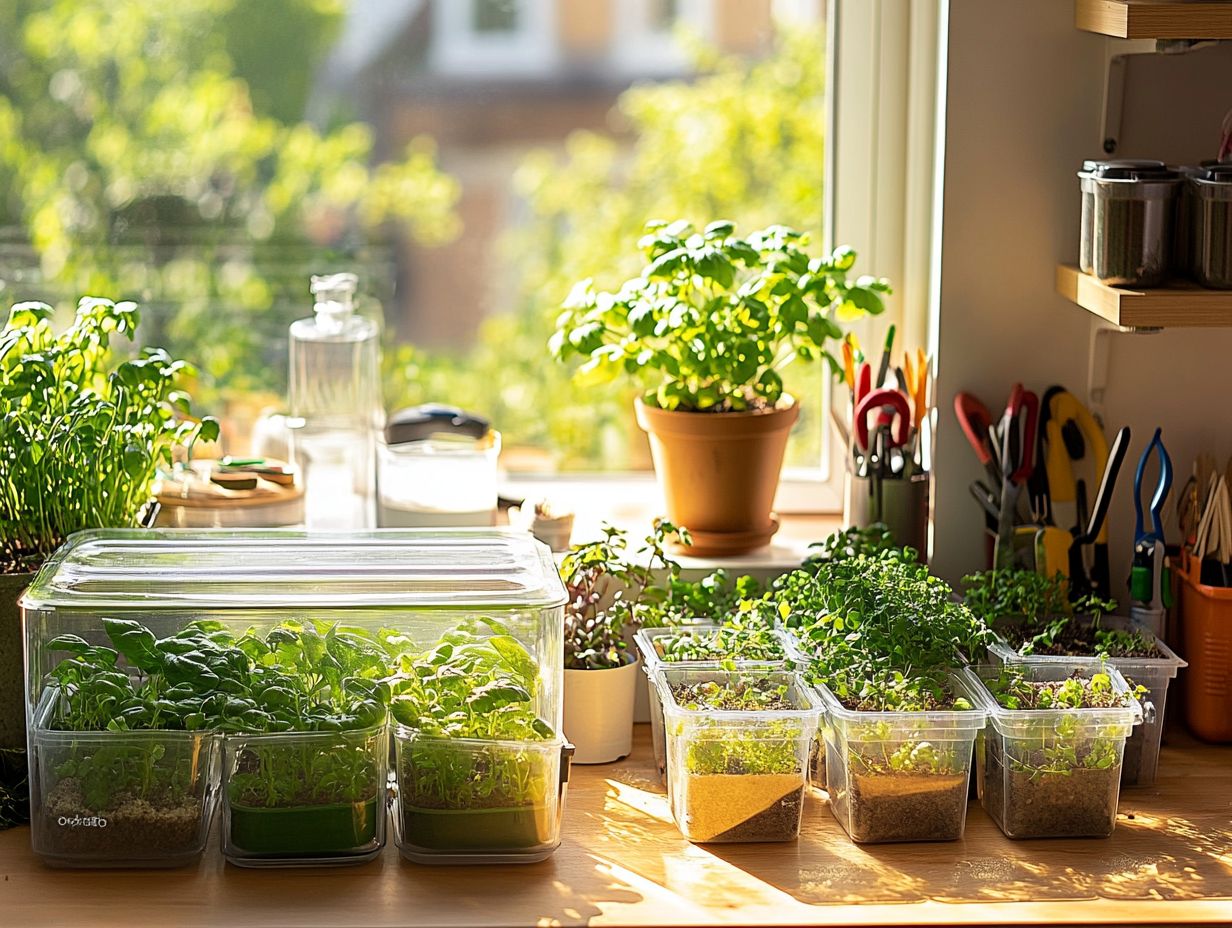
1. How do I start DIY hydroponic gardening today?
To start DIY hydroponic gardening today, gather all necessary materials such as a container, growing medium, nutrient solution, and plants. Then, set up your hydroponic system following a tutorial or guide. Finally, plant your desired crops and monitor their growth.
2. Can I use any container for DIY hydroponic gardening?
Absolutely! You can use various types of containers for DIY hydroponic gardening. Some popular options include plastic buckets, PVC pipes, or even mason jars. Just ensure the container is clean and watertight.
3. How do I choose the right growing medium for my hydroponic system?
The right growing medium for your hydroponic system will depend on the type of plants you want to grow and the system you’re using. Some common options include rockwool, coco coir, perlite, and vermiculite. Research to find the best fit for your specific setup.
4. What type of nutrient solution should I use for my hydroponic garden?
You can make your own nutrient solution using various minerals and chemicals or purchase a pre-made formula from a gardening store. Ensure the solution contains all necessary nutrients for your plants to grow and thrive.
5. Is DIY hydroponic gardening suitable for beginners?
Yes! DIY hydroponic gardening can be a great option for beginners. It is a relatively simple and efficient way to grow plants without soil, and there are plenty of resources and tutorials available to help you get started.
6. Can I grow any type of plant using hydroponic gardening?
Yes, most plants can thrive in a hydroponic system. They need enough water, nutrients, and light to grow well.
Some plants might need special setups or conditions. Researching the specific needs of your chosen plants is key to success.

